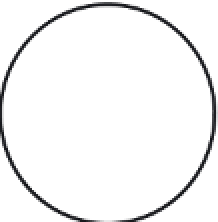Biomedical Engineering Reference
In-Depth Information
FIGURE 1.13
The reduced eye model for simplified calculations of human retinal distances.
cells). Note that the centered optical axis is
slightly different from the physiological visual
axis; although both pass through the nodal point
(optical center) of the eye, the latter is referenced
to the fovea, which is the area of highest acuity
vision on the retina.
To simplify practical calculations related to
the human eye, a method of estimating spatial
distances on the curved surface of the retina
with sufficient accuracy is helpful. A straightfor-
ward technique to convert between angular
span and spatial distance on the retina makes
use of a simplified version of Hemholtz's sche-
matic eye called the
reduced eye model
, shown in
Figure 1.13
[31, 32]
. Compare
Figure 1.13
to
Figure 1.1
. In the reduced eye model, there is a
single refractive surface having a 5.5 mm radius
of curvature and a posterior nodal distance of
16.7 mm. Since a ray passing through the nodal
point is by definition an undeviated ray, an
angular span in degrees can be equated to a
spatial distance on the retina by
As an example, the optic disk
16
in a typical
human eye is roughly circular and has a mean
diameter of 1,800
µ
m
[33]
. This value has been
found to be nearly constant in all humans
regardless of race, sex, or age and is often used
as a yardstick in fundus photographs
[34]
. From
Eq.
(1.10)
, we see that the optic disk subtends an
arc of roughly 6.2°.
Note that because the human eye is not truly
spherical, these distance calculations become
less accurate as one moves away from the region
of the fundus near the optic disk and fovea often
referred to as the
posterior pole
[35]
. However, the
peripheral regions of the retina have no critical
vision anatomy and so are not of great interest
to designers of biomimetic vision sensors. There-
fore, the approximation of Eq.
(1.10)
will usually
suffice.
It may be desirable to compare the spatial reso-
lution of a biomimetic vision sensor to that of the
human eye. An often-quoted resolution limit for
the human eye (based only on the diffraction-
limited point-spread function of the pupil) is
1 min of arc (equivalent to 4.9
µ
m at the posterior
16. 7 mm × tan (1
◦
) = 291. 5
µ
m/ deg.
(1.10)
16
The optic disk is the nearly circular
blind spot
where the optic nerve exits the orb of the eye; no photodetectors
exist inside the area of the optic disk.















































